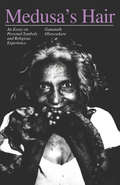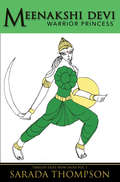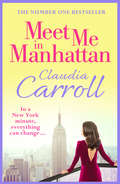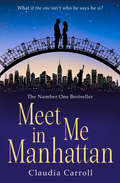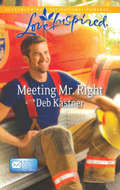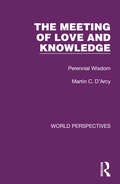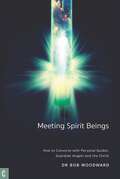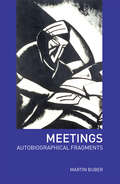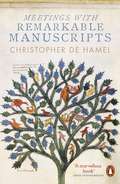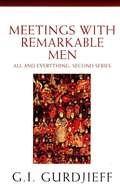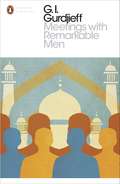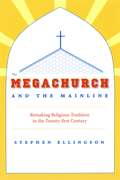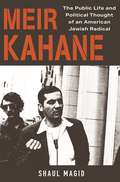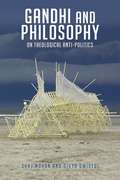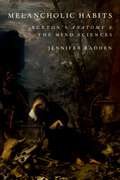- Table View
- List View
Medusa's Hair: An Essay on Personal Symbols and Religious Experience
by Gananath ObeyesekereThe great pilgrimage center of southeastern Sri Lanka, Kataragama, has become in recent years the spiritual home of a new class of Hindu-Buddhist religious devotees. These ecstatic priests and priestesses invariably display long locks of matted hair, and they express their devotion to the gods through fire walking, tongue-piercing, hanging on hooks, and trance-induced prophesying. The increasing popularity of these ecstatics poses a challenge not only to orthodox Sinhala Buddhism (the official religion of Sri Lanka) but also, as Gananath Obeyesekere shows, to the traditional anthropological and psychoanalytic theories of symbolism. Focusing initially on one symbol, matted hair, Obeyesekere demonstrates that the conventional distinction between personal and cultural symbols is inadequate and naive. His detailed case studies of ecstatics show that there is always a reciprocity between the personal-psychological dimension of the symbol and its public, culturally sanctioned role. Medusa's Hair thus makes an important theoretical contribution both to the anthropology of individual experience and to the psychoanalytic understanding of culture. In its analyses of the symbolism of guilt, the adaptational and integrative significance of belief in spirits, and a host of related issues concerning possession states and religiosity, this book marks a provocative advance in psychological anthropology.
Medusa's Hair: An Essay on Personal Symbols and Religious Experience
by Gananath ObeyesekereThe great pilgrimage center of southeastern Sri Lanka, Kataragama, has become in recent years the spiritual home of a new class of Hindu-Buddhist religious devotees. These ecstatic priests and priestesses invariably display long locks of matted hair, and they express their devotion to the gods through fire walking, tongue-piercing, hanging on hooks, and trance-induced prophesying. The increasing popularity of these ecstatics poses a challenge not only to orthodox Sinhala Buddhism (the official religion of Sri Lanka) but also, as Gananath Obeyesekere shows, to the traditional anthropological and psychoanalytic theories of symbolism. Focusing initially on one symbol, matted hair, Obeyesekere demonstrates that the conventional distinction between personal and cultural symbols is inadequate and naive. His detailed case studies of ecstatics show that there is always a reciprocity between the personal-psychological dimension of the symbol and its public, culturally sanctioned role. Medusa's Hair thus makes an important theoretical contribution both to the anthropology of individual experience and to the psychoanalytic understanding of culture. In its analyses of the symbolism of guilt, the adaptational and integrative significance of belief in spirits, and a host of related issues concerning possession states and religiosity, this book marks a provocative advance in psychological anthropology.
Meenakshi Devi: Warrior Princess (Timeless Tales From India #3)
by Sarada ThompsonNo synopsis available.
Meet Me In Manhattan
by Claudia CarrollThe perfect Christmas read for fans of Heidi Swain and Milly Johnson What if THE ONE isn’t who you think he is?
The Meeting of Love and Knowledge: Perennial Wisdom (World Perspectives #4)
by Martin C. D'ArcyOriginally published in 1958 and authored by one of the foremost liberal Catholic theologians of the 20th Century, this book recognizes the need for a greater unity of understanding among all faiths and explores these common grounds with insight and sympathy, bringing to Catholics and non-Catholics alike a full measure of the author’s inspiration and judgement.
The Meeting of Love and Knowledge: Perennial Wisdom (World Perspectives #4)
by Martin C. D'ArcyOriginally published in 1958 and authored by one of the foremost liberal Catholic theologians of the 20th Century, this book recognizes the need for a greater unity of understanding among all faiths and explores these common grounds with insight and sympathy, bringing to Catholics and non-Catholics alike a full measure of the author’s inspiration and judgement.
Meeting Spirit Beings: How to Converse with Personal Guides, Guardian Angels and the Christ
by Bob WoodwardHow can we connect and converse with our personal spirit guides, our guardian angel and even the Christ? In a compelling and uplifting new work, Bob Woodward offers advice and suggestions on how we can link consciously with the spirit beings who seek to support us in everyday life. He demonstrates how, by reaching out to them, we can facilitate greater engagement and even direct dialogue. In the first part of Meeting Spirit Beings, we are introduced to human qualities that can awaken us to our personal spirit guides. 'Intentionality', 'silence', 'trust' and 'gratitude' are all important milestones on our inner path. Bob shares personal reflections as well as actual conversations with his own guides, who offer insights into methods and processes. In the second part of the book, we are encouraged to build a mindful relationship with our guardian angel, who accompanies us on earth, after death and during future incarnations. We are taught how to coordinate our life's path with our angel and to facilitate a healing and supportive relationship. Finally, the author offers transcripts of an extraordinary series of 'conversations' with the Christ being – a dialogue he initiated one Christmas. If Christ is there to offer love and support to all human beings, should it not be possible to enter into direct dialogue with him? Bob's attempts result in an inspiring series of discussions that offer beautiful perceptions of the meaning of life, death and eternity.
Meeting the Alien: An Introduction to Exosociology
by Andreas Anton Michael SchetscheIs mankind alone in the universe? Will we ever encounter intelligent life beyond Earth? These questions have been asked for centuries. Recent advances in the fields of astrophysics, astronomy and astrobiology make it more likely than ever before, that Earth may not be the only inhabited planet, and that humanity may not the only intelligent species in the universe. What would be the consequences of contact with an extraterrestrial intelligence? This question is at the heart of the emerging discipline of exosociology. According to the authors, first contact with an extraterrestrial intelligence poses enormous risks for humanity. These risks come not only from extraterrestrials, but above all from ourselves. We should be prepared. Michael Schetsche and Andreas Anton's comprehensive introduction to exosociology was first published in German in 2019. The book has been widely acclaimed in Germany and internationally. It is now available in English for the first time.
Meetings: Autobiographical Fragments
by Martin BuberMeetings sets forth the life of one of the twentieth-century's greatest spiritual philosophers in his own words. A glittering series of reflections and narratives, it seeks not to describe his life in its full entirety, but rather to convey some of his defining moments of uncertainty, revelation and meaning. Recalling the question on the infinity of space and time which nearly drove Buber to suicide at the age of fourteen, his adolescent 'seduction' by Nietzsche's work, his hero-worship of Ferdinand Lassalle and his love of Bach's music, Meetings has no equal as a portrait of an unique intellect in progress. Like Buber's great works Between Man and Man and The Way of Man, it evokes a tactile, earthly concept of meaning ultimately found, as Maurice Friedman writes in his introduction, 'not in conceptual or systematic thought but in the four-dimensional reality of events and meetings'.
Meetings: Autobiographical Fragments
by Martin BuberMeetings sets forth the life of one of the twentieth-century's greatest spiritual philosophers in his own words. A glittering series of reflections and narratives, it seeks not to describe his life in its full entirety, but rather to convey some of his defining moments of uncertainty, revelation and meaning. Recalling the question on the infinity of space and time which nearly drove Buber to suicide at the age of fourteen, his adolescent 'seduction' by Nietzsche's work, his hero-worship of Ferdinand Lassalle and his love of Bach's music, Meetings has no equal as a portrait of an unique intellect in progress. Like Buber's great works Between Man and Man and The Way of Man, it evokes a tactile, earthly concept of meaning ultimately found, as Maurice Friedman writes in his introduction, 'not in conceptual or systematic thought but in the four-dimensional reality of events and meetings'.
Meetings with Remarkable Manuscripts: Twelve Journeys Into The Medieval World
by Christopher De Hamel'An endlessly fascinating and enjoyable book' Neil MacGregor'Full of delights' Tom StoppardAn extraordinary exploration of the medieval world - the most beguiling history book of the yearThis is a book about why medieval manuscripts matter. Coming face to face with an important illuminated manuscript in the original is like meeting a very famous person. We may all pretend that a well-known celebrity is no different from anyone else, and yet there is an undeniable thrill in actually meeting and talking to a person of world stature.The idea for the book, which is entirely new, is to invite the reader into intimate conversations with twelve of the most famous manuscripts in existence and to explore with the author what they tell us about nearly a thousand years of medieval history - and sometimes about the modern world too. Christopher de Hamel introduces us to kings, queens, saints, scribes, artists, librarians, thieves, dealers, collectors and the international community of manuscript scholars, showing us how he and his fellows piece together evidence to reach unexpected conclusions. He traces the elaborate journeys which these exceptionally precious artefacts have made through time and space, shows us how they have been copied, who has owned them or lusted after them (and how we can tell), how they have been embroiled in politics and scholarly disputes, how they have been regarded as objects of supreme beauty and luxury and as symbols of national identity. The book touches on religion, art, literature, music, science and the history of taste.Part travel book, part detective story, part conversation with the reader, Meetings with Remarkable Manuscripts conveys the fascination and excitement of encountering some of the greatest works of art in our culture which, in the originals, are to most people completely inaccessible. At the end, we have a slightly different perspective on history and how we come by knowledge. It is a most unusual book.
Meetings with Remarkable Men: All And Everything, 2nd Series (All And Everything Ser.)
by G. GurdjieffThe Armenian-Greek spiritual teacher, G.I. Gurdjieff’s autobiographical account of his youth and early travels has become something of a legend since it was first published in 1963. A compulsive read in the tradition of adventure narratives, but suffused with Gurdjieff’s unique perspective on life, it is organized around portraits of remarkable men and women who aided Gurdjieff’s search for hidden knowledge or accompanied him on his journeys in remote parts of the Near East and Central Asia.A classic work, suffused with a haunting sense of what it means to live fully – with conscience, with purpose and with heart.
Meetings with Remarkable Men (Penguin Modern Classics)
by G. I. GurdjieffThe exhilarating, life-affirming call to spiritual arms from world-renowned spiritual teacher G. I. Gurdjieff'Gurdjieff's voice is heard as a call.He calls because he suffers from the inner chaos in which we live.He calls to us to open our eyes.He asks us why we are here, what we wish for, what forces we obey. He asks us, above all, if we understand what we are . . .'Part adventure narrative, part travelogue, part spiritual guide, Meetings with Remarkable Men is suffused with Gurdjieff's unique perspective on life. With vivacity and charm, he organizes his account around portraits of the remarkable men and women who accompanied him through remote parts of the Near East and Central Asia, and who aided his search for hidden knowledge. Among them are Gurdjieff's own father (a traditional bard), a Russian prince dedicated to the search for Truth, a Christian missionary who entered a World Brotherhood deep in Asia, and a woman who escaped slavery to become a trusted member of Gurdjieff's group of fellow seekers.Meetings with Remarkable Men conveys a haunting sense of what it means to live fully - with conscience, with purpose and with heart.
The Megachurch and the Mainline: Remaking Religious Tradition in the Twenty-first Century
by Stephen EllingsonReligious traditions provide the stories and rituals that define the core values of church members. Yet modern life in America can make those customs seem undesirable, even impractical. As a result, many congregations refashion church traditions so they may remain powerful and salient. How do these transformations occur? How do clergy and worshipers negotiate which aspects should be preserved or discarded? Focusing on the innovations of several mainline Protestant churches in the San Francisco Bay Area, Stephen Ellingson’s The Megachurch and the Mainline provides new understandings of the transformation of spiritual traditions. For Ellingson, these particular congregations typify a new type of Lutheranism—one which combines the evangelical approaches that are embodied in the growing legion of megachurches with American society’s emphasis on pragmatism and consumerism. Here Ellingson provides vivid descriptions of congregations as they sacrifice hymns in favor of rock music and scrap traditional white robes and stoles for Hawaiian shirts, while also making readers aware of the long history of similar attempts to Americanize the Lutheran tradition. This is an important examination of a religion in flux—one that speaks to the growing popularity of evangelicalism in America.
The Megachurch and the Mainline: Remaking Religious Tradition in the Twenty-first Century
by Stephen EllingsonReligious traditions provide the stories and rituals that define the core values of church members. Yet modern life in America can make those customs seem undesirable, even impractical. As a result, many congregations refashion church traditions so they may remain powerful and salient. How do these transformations occur? How do clergy and worshipers negotiate which aspects should be preserved or discarded? Focusing on the innovations of several mainline Protestant churches in the San Francisco Bay Area, Stephen Ellingson’s The Megachurch and the Mainline provides new understandings of the transformation of spiritual traditions. For Ellingson, these particular congregations typify a new type of Lutheranism—one which combines the evangelical approaches that are embodied in the growing legion of megachurches with American society’s emphasis on pragmatism and consumerism. Here Ellingson provides vivid descriptions of congregations as they sacrifice hymns in favor of rock music and scrap traditional white robes and stoles for Hawaiian shirts, while also making readers aware of the long history of similar attempts to Americanize the Lutheran tradition. This is an important examination of a religion in flux—one that speaks to the growing popularity of evangelicalism in America.
The Megachurch and the Mainline: Remaking Religious Tradition in the Twenty-first Century
by Stephen EllingsonReligious traditions provide the stories and rituals that define the core values of church members. Yet modern life in America can make those customs seem undesirable, even impractical. As a result, many congregations refashion church traditions so they may remain powerful and salient. How do these transformations occur? How do clergy and worshipers negotiate which aspects should be preserved or discarded? Focusing on the innovations of several mainline Protestant churches in the San Francisco Bay Area, Stephen Ellingson’s The Megachurch and the Mainline provides new understandings of the transformation of spiritual traditions. For Ellingson, these particular congregations typify a new type of Lutheranism—one which combines the evangelical approaches that are embodied in the growing legion of megachurches with American society’s emphasis on pragmatism and consumerism. Here Ellingson provides vivid descriptions of congregations as they sacrifice hymns in favor of rock music and scrap traditional white robes and stoles for Hawaiian shirts, while also making readers aware of the long history of similar attempts to Americanize the Lutheran tradition. This is an important examination of a religion in flux—one that speaks to the growing popularity of evangelicalism in America.
Mehrdeutige Körper: Über die Anerkennung intergeschlechtlicher Menschen in Theologie und Kirche (Religionswissenschaft #35)
by Katharina Mairinger-ImmischIntergeschlechtlichkeit bekommt verstärkt mediale Aufmerksamkeit - nicht aber in der katholischen Kirche und Theologie. Ausgehend von den religionssoziologischen Beobachtungen Pierre Bourdieus als auch von der freiheitstheologischen Anthropologie Thomas Pröppers wirft Katharina Mairinger-Immisch einen kritischen Blick auf die katholische Geschlechteranthropologie. Sie entwickelt dabei eine geschlechterinklusive Ethik, die die Haltung der Ambiguitätstoleranz fordert und fördert: eine Handlungsorientierung für die Anerkennung intergeschlechtlicher Menschen.
Meir Kahane: The Public Life and Political Thought of an American Jewish Radical
by Shaul MagidThe life and politics of an American Jewish activist who preached radical and violent means to Jewish survivalMeir Kahane came of age amid the radical politics of the counterculture, becoming a militant voice of protest against Jewish liberalism. Kahane founded the Jewish Defense League in 1968, declaring that Jews must protect themselves by any means necessary. He immigrated to Israel in 1971, where he founded KACH, an ultranationalist and racist political party. He would die by assassination in 1990. Shaul Magid provides an in-depth look at this controversial figure, showing how the postwar American experience shaped his life and political thought.Magid sheds new light on Kahane’s radical political views, his critique of liberalism, and his use of the “grammar of race” as a tool to promote Jewish pride. He discusses Kahane’s theory of violence as a mechanism to assure Jewish safety, and traces how his Zionism evolved from a fervent support of Israel to a belief that the Zionist project had failed. Magid examines how tradition and classical Jewish texts profoundly influenced Kahane’s thought later in life, and argues that Kahane’s enduring legacy lies not in his Israeli career but in the challenge he posed to the liberalism and assimilatory project of the postwar American Jewish establishment.This incisive book shows how Kahane was a quintessentially American figure, one who adopted the radicalism of the militant Left as a tenet of Jewish survival.
Meister Eckhart: Master of Mystics
by Richard WoodsTimothy Radcliffe introduces this masterly short guide to Eckhart's mystical teaching - perfectly pitched for those interested in spirituality and theology. Richard Woods writes as a passionate advocate of Eckhart's relevance to issues and challenges facing intelligent people today with emphasis on religious understanding, belief, action and human suffering. The fruit of more than ten years of reflection, Meister Eckhart: Master of Mystics explores a set of related themes bridging Eckhart's medieval world and our own turbulent times - women's role in spirituality and church life, global climate change and the sacredness of Creation, the meaning of detachment, the blind alleys of spiritual 'technology', the meaning of contemplation and the place of prayer, Eckhart's views on art and spirituality, his daring insights into the challenges of pain and suffering, and Eckhart's relevance for wider and deeper encounter among world religions. Other chapters investigate Eckhart's wide-ranging sources and his revolutionary approach to the redeeming mission of Jesus Christ.
Meister Eckhart and the Beguine Mystics: Hadewijch of Brabant, Mechthild of Magdeburg, and Marguerite Porete
by Bernard McGinnThe great German mystic Meister Eckhart remains one of the most fascinating figures in Western thought. Revived interest in Eckhart's mysticism has been matched, and even surpassed, by the study of the women mystics of the late13th century. This book argues that Eckhart's thought cannot be fully be understood until it is viewed against the background of the breakthroughs made by the women mystics who preceded him.
Melancholic Freedom: Agency and the Spirit of Politics (AAR Reflection and Theory in the Study of Religion)
by David Kyuman KimWhy does agency -- the capacity to make choices and to act in the world -- matter to us? Why is it meaningful that our intentions have effects in the world, that they reflect our sense of identity, that they embody what we value? What kinds of motivations are available for political agency and judgment in an age that lacks the enthusiasm associated with the great emancipatory movements for civil rights and gender equality? What are the conditions for the possibility of being an effective agent when the meaning of democracy has become less transparent? David Kyuman Kim addresses these crucial questions by uncovering the political, moral, philosophical, and religious dimensions of human agency. Kim treats agency as a form of religious experience that reflects implicit and explicit notions of the good. Of particular concern are the moral, political, and religious motivations that underpin an understanding of agency as meaningful action. Through a critical engagement with the work of theorists such as Judith Butler, Charles Taylor, and Stanley Cavell, Kim argues that late modern and postmodern agency is found most effectively at work in what he calls "projects of regenerating agency" or critical and strategic responses to loss. Agency as melancholic freedom begins and endures, Kim maintains, through the moral and psychic losses associated with a broad range of experiences, including the moral identities shaped by secularized modernity and the multifold forms of alienation experienced by those who suffer the indignities of racial, gender, class, and sexuality discrimination and oppression. Kim calls for renewing the sense of urgency in our political and moral engagements by seeing agency as a vocation, where the aspiration for self-transformation and the human need for hope are fundamental concerns.
Melancholic Habits: Burton's Anatomy & the Mind Sciences
by Jennifer RaddenJennifer Radden here provides a re-interpretation of the classic text by 17th century scholar Robert Burton, The Anatomy of Melancholy. Her new reading of Burton's essential text brings several key facets of his thought to light: the role of imagination in inciting and averting melancholy as disorder; the part played by daily habits of thought in engendering severe and incurable conditions; the multi-directional feedback loops linking feeling and thought in his model of mind; and an emphasis on symptoms and natural history in his understanding of disease. Much of Burton's account is derived from classical, medieval and renaissance writing about melancholy, yet he brought them together into something new: an account that -- while it stands in contrast to many of the assumptions of later psychology -- concurs surprisingly well with present day cognitivism. Moreover, although seventeenth century melancholy bears only a loose relationship to present day mood disorders such as depression and anxiety, on this reading the Anatomy anticipates a considerable number of findings and hypotheses associated with present day psychiatry, including its network models of depression, for example, and its emphasis on the part played by rumination and mind wandering in engendering affective disorder. Radden's new reading of a classic text should interest readers in philosophy of mind and psychiatry, clinical psychiatry and the history of medicine.
Melancholic Habits: Burton's Anatomy & the Mind Sciences
by Jennifer RaddenJennifer Radden here provides a re-interpretation of the classic text by 17th century scholar Robert Burton, The Anatomy of Melancholy. Her new reading of Burton's essential text brings several key facets of his thought to light: the role of imagination in inciting and averting melancholy as disorder; the part played by daily habits of thought in engendering severe and incurable conditions; the multi-directional feedback loops linking feeling and thought in his model of mind; and an emphasis on symptoms and natural history in his understanding of disease. Much of Burton's account is derived from classical, medieval and renaissance writing about melancholy, yet he brought them together into something new: an account that -- while it stands in contrast to many of the assumptions of later psychology -- concurs surprisingly well with present day cognitivism. Moreover, although seventeenth century melancholy bears only a loose relationship to present day mood disorders such as depression and anxiety, on this reading the Anatomy anticipates a considerable number of findings and hypotheses associated with present day psychiatry, including its network models of depression, for example, and its emphasis on the part played by rumination and mind wandering in engendering affective disorder. Radden's new reading of a classic text should interest readers in philosophy of mind and psychiatry, clinical psychiatry and the history of medicine.
